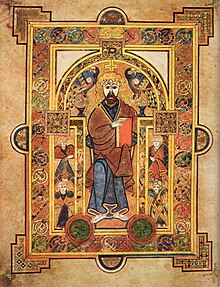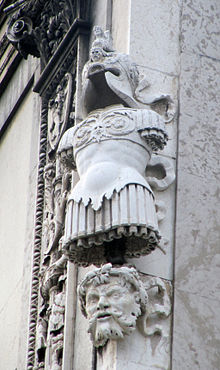Portal:Visual arts
Introduction

The visual arts are art forms such as painting, drawing, printmaking, sculpture, ceramics, photography, video, filmmaking, comics, design, crafts, and architecture. Many artistic disciplines, such as performing arts, conceptual art, and textile arts, also involve aspects of the visual arts as well as arts of other types. Also included within the visual arts are the applied arts, such as industrial design, graphic design, fashion design, interior design, and decorative art.
Current usage of the term "visual arts" includes fine art as well as applied or decorative arts and crafts, but this was not always the case. Before the Arts and Crafts Movement in Britain and elsewhere at the turn of the 20th century, the term 'artist' had for some centuries often been restricted to a person working in the fine arts (such as painting, sculpture, or printmaking) and not the decorative arts, crafts, or applied visual arts media. The distinction was emphasized by artists of the Arts and Crafts Movement, who valued vernacular art forms as much as high forms. Art schools made a distinction between the fine arts and the crafts, maintaining that a craftsperson could not be considered a practitioner of the arts. The increasing tendency to privilege painting, and to a lesser degree sculpture, above other arts has been a feature of Western art as well as East Asian art. In both regions, painting has been seen as relying to the highest degree on the imagination of the artist and being the furthest removed from manual labour – in Chinese painting, the most highly valued styles were those of "scholar-painting", at least in theory practiced by gentleman amateurs. The Western hierarchy of genres reflected similar attitudes. (Full article...)
Selected article
The Book of Kells (Latin: Codex Cenannensis; Irish: Leabhar Cheanannais; Dublin, Trinity College Library, MS A. I. [58], sometimes known as the Book of Columba) is an illuminated manuscript and Celtic Gospel book in Latin, containing the four Gospels of the New Testament together with various prefatory texts and tables. It was created in a Columban monastery in either Ireland or Scotland, and may have had contributions from various Columban institutions from each of these areas. It is believed to have been created c. 800 AD. The text of the Gospels is largely drawn from the Vulgate, although it also includes several passages drawn from the earlier versions of the Bible known as the Vetus Latina. It is regarded as a masterwork of Western calligraphy and the pinnacle of Insular illumination. The manuscript takes its name from the Abbey of Kells, County Meath, which was its home for centuries.
The illustrations and ornamentation of the Book of Kells surpass those of other Insular Gospel books in extravagance and complexity. The decoration combines traditional Christian iconography with the ornate swirling motifs typical of Insular art. Figures of humans, animals and mythical beasts, together with Celtic knots and interlacing patterns in vibrant colours, enliven the manuscript's pages. Many of these minor decorative elements are imbued with Christian symbolism and so further emphasise the themes of the major illustrations. (Full article...)Selected picture
Selected quote
| “ | Most painting in the European tradition was painting the mask. Modern art rejected all that. Our subject matter was the person behind the mask. | ” |
| — Robert Motherwell, The Times (November 17, 1985) |
Related portals
Selected biography
Gasparo Cairano, also known as Gasparo da Cairano, de Cayrano, da Milano, Coirano, and other variations (born Milan or Pieve del Cairo or Cairate, before 1489 – Brescia, died before 1517), was an Italian Renaissance sculptor.
The artist emerged in 1489 as part of the cultural world of Milan, beginning a successful career that turned him into a leading exponent of Renaissance sculpture in Brescia, distinguishing himself with works of cultural import such as his cycle of the Caesars for the Loggia palace in Brescia, as well as the Mausoleum of Martinengo. He introduced a powerful and highly expressive classical taste, as opposed to the hitherto existing refined decorativeness. During the first decade of the sixteenth century, Gasparo was able to win over public and private clients who sought to translate into stone their pride in their supposed historical descent from ancient Rome. (Full article...)Did you know (auto generated) -

- ... that André Delvaux was a magic-realist filmmaker who was made a baron by the king of Belgium?
- ... that the documentary comedy films Being Canadian and When Jews Were Funny explore the filmmakers' cultural identity through interviews with dozens of comedians?
- ... that Diminish and Ascend has been called a real-life M. C. Escher drawing?
- ... that entry to the British Royal Military Academy required the use of a drawing triangle with a completely different purpose from those used today?
- ... that Bernie Wrightson spent seven years drawing an illustrated edition of Mary Shelley's 1818 novel Frankenstein?
- ... that John Hoke III, who is dyslexic and the chief design officer of Nike, has described drawing as his first language?
- ... that Mexican filmmaker David Zonana wrote his first feature film after producing for two other directors?
- ... that after Sydney Parkinson died on the return leg of the first voyage of James Cook, some of his drawings were engraved for publication in his Journal of a Voyage to the South Seas?
General images
Major topics
- Types of visual art – Architecture • Art intervention • Ceramic art • Computer art • Drawing • Fashion • Film • Installation art • Land art • Mixed media • Painting • Performance art • Photography • Printmaking • Sculpture • Stained glass
- Art history – Pre-historic art • Ancient art • Art of Ancient Egypt • Art in Ancient Greece • Minoan pottery • Scythian art • Roman art • Women artists
- Western art periods and movements – Medieval art • Gothic art • Renaissance • Mannerism • Baroque • Rococo • Neoclassicism • Romanticism • Realism • Modern Art • Impressionism • Symbolism • Fauvism • Proto-Cubism • Cubism • Futurism • Dada • Art Deco • Surrealism • Abstract Expressionism • Lyrical abstraction • Conceptual Art • Contemporary Art • Postmodern art visual arts.
- Eastern and Middle Eastern art – Buddhist art • Chinese art • Islamic art • Japanese art • Laotian art • Thai art • Tibetan art
- Lists – Architects • Art movements • Art periods • Painters • Printmakers • Sculptors • Statues
- Lists of basic topics – Visual arts • Architecture • Film • Painting • Photography • Sculpture
Subcategories

Architecture | Ceramic art | Comics | Crafts | Design | Drawing | Illustration | Film | Glass | Graphic design | Industrial design | Landscape architecture | Multimedia | Painting | Photography | Pottery | Printmaking | Public art | Sculpture | Typography | Mosaic
Artists | Visual arts awards | Artist collectives | Art collectors | Art critics | Art curators | Visual arts exhibitions | Art forgery | Art history | Visual arts materials | Art schools | Artistic techniques |
WikiProjects
Things you can do
Associated Wikimedia
The following Wikimedia Foundation sister projects provide more on this subject:
-
Commons
Free media repository -
Wikibooks
Free textbooks and manuals -
Wikidata
Free knowledge base -
Wikinews
Free-content news -
Wikiquote
Collection of quotations -
Wikisource
Free-content library -
Wikiversity
Free learning tools -
Wiktionary
Dictionary and thesaurus

















































































